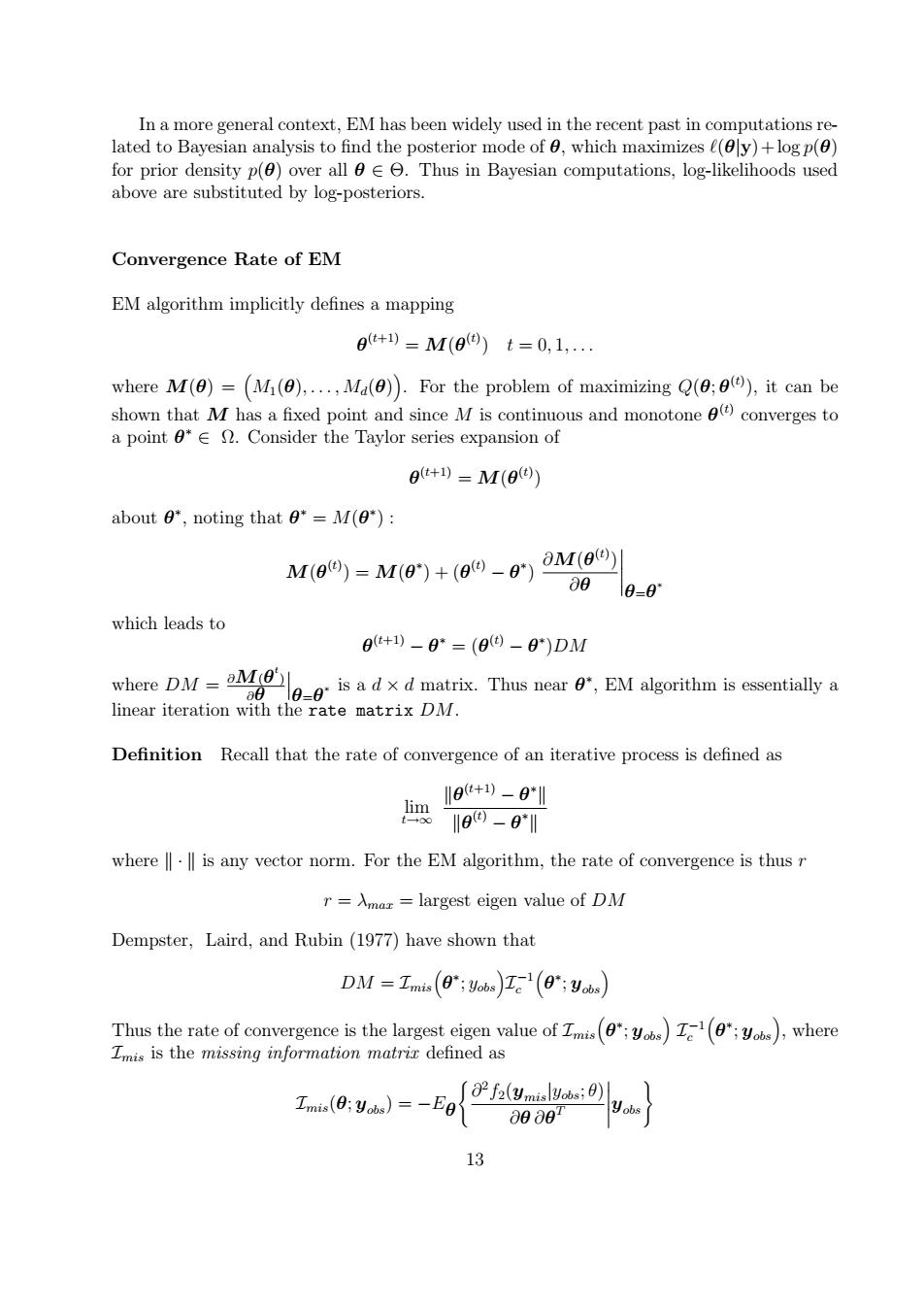正在加载图片...

In a more general context,EM has been widely used in the recent past in computations re- lated to Bayesian analysis to find the posterior mode ofθ,which maximizes e(θy)+logp(θ) for prior density p()over all a ee.Thus in Bayesian computations,log-likelihoods used above are substituted by log-posteriors. Convergence Rate of EM EM algorithm implicitly defines a mapping 0+1)=M(0)t=0,1,. where M()=(Mi(0),...,Ma()).For the problem of maximizing Q(0(),it can be shown that M has a fixed point and since M is continuous and monotone 0()converges to a point 0*e Consider the Taylor series expansion of 0+)=M(0) about 0*,noting that 0*=M(*): M0)=M(0)+(a-9)0Ma9) ∂8 10=0 which leads to 0t+)-0*=(0⊙-0*)DM whereDdmatix ThusearEMrt isentiallya linear iteration with the rate matrix DM. Definition Recall that the rate of convergence of an iterative process is defined as 8+)-0*l lim 109-0川 where is any vector norm.For the EM algorithm,the rate of convergence is thus r r =Amaz largest eigen value of DM Dempster,Laird,and Rubin (1977)have shown that DM =Imis(0";Vobs)Tc0";yos) Thus the rate of convergence is the largest eigen value of Imis (T),where Imis is the missing information matrir defined as Imis(0:yobs)=-E ∫0Pf2(mis Yobs:0u 00001 13In a more general context, EM has been widely used in the recent past in computations related to Bayesian analysis to find the posterior mode of θ, which maximizes `(θ|y)+log p(θ) for prior density p(θ) over all θ ∈ Θ. Thus in Bayesian computations, log-likelihoods used above are substituted by log-posteriors. Convergence Rate of EM EM algorithm implicitly defines a mapping θ (t+1) = M(θ (t) ) t = 0, 1, . . . where M(θ) = M1(θ), . . . , Md(θ) . For the problem of maximizing Q(θ; θ (t) ), it can be shown that M has a fixed point and since M is continuous and monotone θ (t) converges to a point θ ∗ ∈ Ω. Consider the Taylor series expansion of θ (t+1) = M(θ (t) ) about θ ∗ , noting that θ ∗ = M(θ ∗ ) : M(θ (t) ) = M(θ ∗ ) + (θ (t) − θ ∗ ) ∂M(θ (t) ) ∂θ
θ=θ ∗ which leads to θ (t+1) − θ ∗ = (θ (t) − θ ∗ )DM where DM = ∂M(θ t ) ∂θ
θ=θ ∗ is a d × d matrix. Thus near θ ∗ , EM algorithm is essentially a linear iteration with the rate matrix DM. Definition Recall that the rate of convergence of an iterative process is defined as lim t→∞ kθ (t+1) − θ ∗ k kθ (t) − θ ∗ k where k · k is any vector norm. For the EM algorithm, the rate of convergence is thus r r = λmax = largest eigen value of DM Dempster, Laird, and Rubin (1977) have shown that DM = Imis θ ∗ ; yobs I −1 c θ ∗ ; yobs Thus the rate of convergence is the largest eigen value of Imis θ ∗ ; yobs I −1 c θ ∗ ; yobs , where Imis is the missing information matrix defined as Imis(θ; yobs) = −Eθ ( ∂ 2 f2(ymis|yobs; θ) ∂θ ∂θ T
yobs) 13